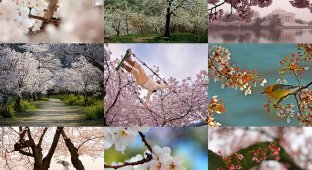Usually lilacs bloom in early May, but this year in many cities its flowering began two weeks earlier, since spring arrived quite abruptly and was marked by high temperatures. The delicate scent of lilac and its lush color have long become a symbol of the awakening of nature and the beginning of a truly warm season.
We present to you a selection of a couple of dozen photographs, looking at which, if you have a good imagination, you can even feel the delicate aroma of lilac, familiar from childhood.


1.
One day, while walking through the forest, the god of forests and fields - Pan, who has goat legs, a beard and horns, saw a beautiful young nymph, a gentle messenger of the dawn, named Syringa. Fascinated by her grace, elegance and beauty, Pan wanted to embrace the girl, but when she saw him, she got scared and began to run wherever her eyes were looking. Pan chased after her and, when he had almost caught up with her, she suddenly turned into a beautiful plant with fragrant flowers. Dejected, the god of the forests sat down next to a bush and began to cry. As a consolation, he cut a twig from a bush and made a pipe out of it. And since then, he has been walking through the fields and meadows, playing wonderful melodies on his pipe, trying to do only good to everyone on his way, and to the sound of this wonderful pipe, all adversity is forgotten. The Latin name for lilac comes from the name of the beautiful Syringa.

2.

3.
The lilac is blooming, what peace...
And inhaling the sweet smell of petals,
I touch with my hand, double flowers
Stealthily, thoughts come and already
Currents run through the body
From the happiness of being alone
The color of the tall bush gives me
And I stand stupefied
I'm under the yellow-eyed moon
Oh life, how I love you
Lilacs bloom, continue the fairy tale!

4.

5.

6.
The homeland of lilac is Persia. It came to Europe only in the 16th century. In 1562, it was brought to Vienna from Constantinople by the ambassador of Emperor Ferdinand Angerius Busberg, who was under Sultan Soliman. Around the same time, lilacs also came to England. There is a description of Queen Elizabeth's country castle park that says that there were six lilac bushes growing near one of the several marble pools.

7.

8.
In the 16th century, lilacs were very rare in Europe, but soon they began to be grown in almost all parks and gardens, which in the spring were filled with the wonderful fragrance of wildly blooming white and purple flowers. Lilacs were especially loved in Germany. In the spring, almost all houses were decorated with it, wreaths were woven from it, bouquets were made from it. Girls used lilacs for fortune telling: it was believed that if you find a five-petalled lilac flower, it means you will be happy. In England, on the contrary, lilac was considered a flower of grief and misfortune. In the East, lilac flowers are a symbol of the separation of lovers. In Russia, lilacs have always grown in ancient landowner estates. It was grown in gardens and parks, and planted near mansions. When spring came, these gardens were filled with a sea of blooming and fragrant lilacs. This was an integral element of life on Russian estates. Many Russian artists loved to depict lilacs. It is enough to recall at least the amazingly poetic paintings of M. Vrubel.

9.

10.

eleven.

12.

13.
A Scandinavian legend tells that one day the goddess Spring woke up the Sun and raised it high above the earth. Together with the rainbow Iris, they began to circle the earth. Spring took the rays of the sun, mixed them with different colors of the rainbow and scattered them across the earth. And where these rays fell, colorful flowers bloomed - red, blue, orange and light blue. When the Sun, Spring and Rainbow reached the North, where the countries of Scandinavia were, the rainbow had only purple and white colors left. Then Spring took the color purple and the sunbeam and threw them down on the Scandinavian lands. Lilac flowers scattered like wonderful stars on the green bushes. Then, when Spring had only the white color left, she scattered it with a generous hand and it turned out to be a white star lilac.

14.

15.

16.

17.

18.

19.

20.

21.

22.

23.

24.






















